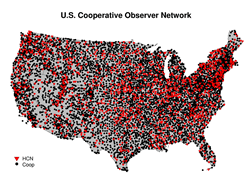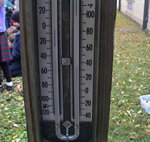Gardens Emerged or Blooming

Who is watching and recording the weather? Every dot on this map is a cooperating weather recorder! >>
This week's tulip map shares the story of spring-like temperatures. Where is the green this week? Can you see a pattern across North America? Describe it to a friend.
There are 23 gardens showing tulips emerging. Where will the next tulips emerge? Study the map and make your prediction.
 |
||
| map/sightings (Eurasia) |
map/sightings (Asia) |
|
Do
you ever wonder about the information that is used to make weather
and climate maps? Check out: This Week's Map Questions (Handout) >> |
||
Gardeners comment on unusual events:
- "Today we observed about 6 of our tulips emerge from our garden. Earthworms were also spotted. This year has been unusually cold, with more snow than normal. It was even snowing lightly when we observed our tulips. " -Forest Grove, OR 02/09/09
- "Today the two tulip beds had about 8 little light green tulip plants emerging one inch out of the soil. 'Staten Island Chuck,' New York's groundhog, predicted spring—and here is is a week later. Finally!" - New York, NY 02/09/09
- "Earlier emergence than the previous 2 years. First one this year appeared around January 30, 2009. Several are up today, February 7. Usually the first one appears around February 9." - Ogden, UT 02/07/09
| Did
You Know? |
>>
|
||
| The old saying is "climate is what we expect and weather is what we get." | |||
| Climate:
The average weather pattern of a region over at least a 30-year period.
(Note that the climate may be different if weather patterns are averaged
over different periods of time ...30 years or 1000 years, for example). Weather: The current activity of the atmosphere, including temperature, wind, clouds, and precipitation. |
|||
Did
You Know? You Are a Meteorologist Follow Your Weather: You can set up a weather station, or simply go out and track the weather at your school. |
|||
| You're the Scientist: | |||
|
|||
Sharpen your observation skills! Use them to learn more about your garden as it emerges and grows this spring. Begin looking carefully and closely at an emerging garden. How many things do you notice? Write them down!
Try
This!
|
 Look closely.What do you see? >> |

A simple thermometer opens the world of meterology at your school.
The
Next Tulip Garden Update Will Be Posted on February 19, 2009.







